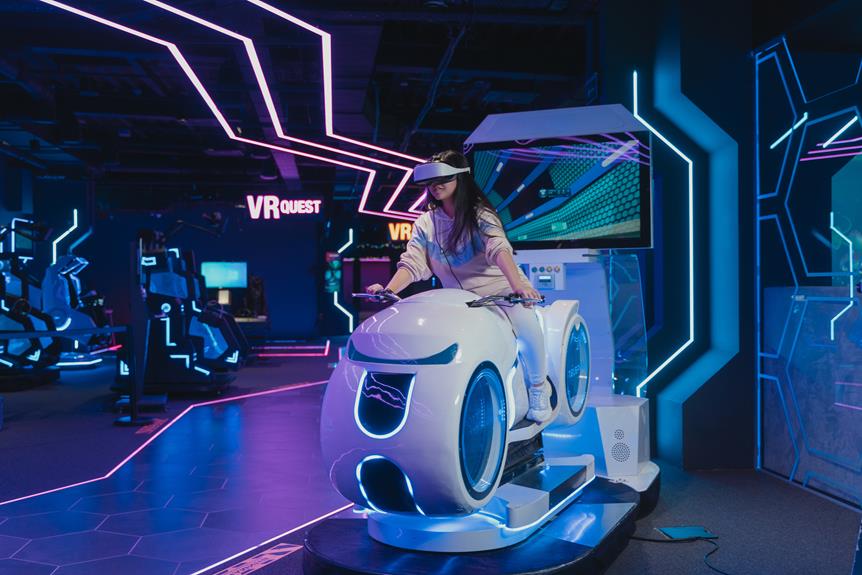The art of simulation is a tool capable of unleashing a powerful potential for innovation, while providing a risk-free environment in which to experiment.
As technologies advance and computational power increases, simulation is increasingly viewed as a viable means of achieving progress and driving change.
This article will explore the current and potential uses of simulation, its advantages and disadvantages, and the ever-evolving future trends that are impacting its development.
Join us as we explore the possibilities of simulation and its potential to revolutionize the world.
Key Takeaways
- Simulation allows experimentation without risk.
- It provides detailed insights into system behavior.
- Simulation enables the optimization of design.
- The use of simulation is expected to grow in the future, especially in fields like virtual reality, artificial intelligence, and medicine.
What Is Simulation
Simulation is an innovative method of risk-free experimentation that utilizes models or computer programs to replicate real-world phenomena or processes. This allows engineers and scientists to observe how systems or processes behave under different conditions without the dangers posed by real-world testing.
Simulation also provides detailed insights into the behavior of systems or processes, opens up opportunities for the optimization of design, and offers safer and more reliable options. It is used in many industries, including gaming, finance, aerospace, automotive, and healthcare, to analyze and optimize manufacturing processes, test and validate new designs, and support decision-making and scenario analysis.
Simulation is set to become even more important for virtual reality and augmented reality applications, autonomous systems, and fields such as medicine and urban planning in the future.
Advantages of Simulation
Simulation offers numerous advantages, such as the ability to experiment without risk, detailed insights into system behavior, and improved safety and reliability. It can also be used for training and education, as well as for optimizing design. Moreover, simulation offers a range of benefits for businesses, including:
- Simulation for disaster preparedness: preparing for potential disasters or emergencies.
- Simulation for financial forecasting: predicting the future of the stock market.
- Simulation for training and education: improving performance and safety.
- Simulation for research and development: testing new technologies and designs.
Simulation is an invaluable tool for businesses, allowing them to explore and experiment without risking real-world resources. This technology is becoming increasingly sophisticated, offering businesses the opportunity to prepare for disaster, predict the future, and explore new possibilities with greater accuracy.
Disadvantages of Simulation
Despite its many advantages, simulation does have some drawbacks. These accuracy limitations can be an issue, as the models used are not always able to account for all variables and factors. Additionally, the cost effectiveness trade-off must be considered, as the software, hardware, and development resources required for simulation can be quite expensive. Finally, the complexity of the models and the need for specialized knowledge to create and use them can be a challenge.
Despite these drawbacks, simulation remains an invaluable tool for experimentation and optimization. It provides a risk-free environment for testing and training.
Applications of Simulation
The use of simulation is widespread across many industries, including aerospace, automotive, and healthcare, to analyze and optimize manufacturing processes. Simulation can also be applied in other areas such as gaming, climate modeling, training and education, and decision-making.
Enhancing safety and reliability
Facilitating training and education
Supporting decision-making and scenario analysis
Allowing experimentation without risk
Simulation has become an invaluable tool in many aspects of modern life, offering organizations the ability to experiment without risk, enhance safety, and optimize designs. From gaming to climate modeling, simulation has allowed people to explore and understand the complexities of the world around us, leading to more informed decisions and greater efficiency.
Future Trends in Simulation
As technology advances and more data becomes available, simulation is becoming increasingly important for the development of autonomous systems, virtual reality, and augmented reality applications.
Simulation has also been applied in gaming to create realistic environments, and in climate modeling to better understand climate change and its effects.
In the future, the use of simulation is expected to grow, with advancements in computational power and modeling techniques enabling more detailed and accurate simulations. AI and machine learning will also be integrated to create more sophisticated systems.
Simulation will have a major role in the development of autonomous systems, and will be used to test and validate new technologies or designs. It will also be used in fields like medicine and urban planning to optimize designs and make more informed decisions.
The future of simulation will be one of innovation and risk-free experimentation.
Simulation in Virtual Reality and Augmented Reality
With the increasing popularity of virtual and augmented reality technologies, simulation is becoming an essential tool for creating realistic and immersive experiences. From virtual reality training to augmented reality simulations, this technology can be used to simulate a variety of scenarios without any risk.
Here are four main advantages of using simulation in virtual and augmented reality:
- Enhanced safety as there is no risk of physical harm.
- Cost-effective as simulated systems can be used instead of expensive hardware.
- Reduced development time as simulations can be created quickly and easily.
- Improved accuracy of simulation models.
Simulation technology is revolutionizing the way we experience virtual and augmented reality. It provides a safe and cost-effective way to experiment with various scenarios, allowing developers to quickly create realistic simulations and training environments.
Computational Power and Modeling Techniques
Recent advancements in computational power and modeling techniques have enabled simulation to become an increasingly powerful tool for virtual and augmented reality applications.
Simulation techniques have evolved significantly, allowing for more complex and data-driven models. This has allowed for greater accuracy in simulating real-world scenarios and phenomena.
With the combination of simulation and data analytics, simulations can be used to analyze complex systems, optimize design choices, and train personnel in a risk-free environment.
Such advancements have improved the safety, reliability, and cost-effectiveness of simulations, making them a valuable tool for innovation.
AI and Machine Learning in Simulation
Simulation is being further refined through the integration of artificial intelligence (AI) and machine learning, allowing for greater optimization and accuracy in simulating real-world scenarios. AI and machine learning can be utilized to create more realistic simulations in areas like gaming, finance, and urban planning. By incorporating these technologies, simulations can be more accurately calibrated to predict outcomes and provide valuable insights.
Here are four ways AI and machine learning are impacting simulation:
- AI-driven simulations can detect patterns and trends that are not easily seen by humans.
- Machine learning algorithms can improve the accuracy of simulations, providing greater realism.
- AI-powered simulations can be used in gaming to create more immersive and interactive experiences.
- Simulations in finance can leverage AI to provide more accurate predictions of market movements.
The integration of AI and machine learning into simulation is leading to increased accuracy and realism, providing a more lifelike experience. This is allowing for more efficient and risk-free experimentation, enabling the development of more effective solutions.
Autonomous Systems and Simulation
Recently, simulation has become a powerful tool in the development of autonomous systems, allowing for risk-free experimentation and optimization.
Autonomous systems are rapidly transforming various sectors such as transportation and robotics, and simulation is playing an important role in their development.
Simulation enables engineers to test and evaluate their designs in a virtual environment, without the risks associated with real-world experiments. This has enabled the development of autonomous systems that are safer, more reliable, and more efficient.
Simulation also allows engineers to explore different scenarios and optimize their designs. With the continued advancements in computational power and modeling techniques, simulation will continue to play an important role in the development of autonomous systems.
The potential applications of simulation in autonomous systems are limitless, and the possibilities are only beginning to be explored.
Simulation in Medicine and Urban Planning
In recent years, simulation has become increasingly important for medicine and urban planning, enabling risk-free experimentation and optimization. It has enabled healthcare professionals to test treatments, given transportation planners the ability to visualize and optimize traffic scenarios, and provided city planners with an invaluable tool for understanding the effects of population growth on the environment.
Here are some key benefits of simulation in these fields:
- Simulation in healthcare can help reduce costs and improve patient safety.
- Simulation in transportation planning can help reduce traffic congestion and optimize routes.
- Simulation in urban planning can help identify the most efficient use of resources.
- Simulation can help identify potential risks and develop strategies for mitigating them.
Simulation is an invaluable tool for understanding and predicting the behavior of complex systems. It is a powerful tool for enabling innovation and risk-free experimentation, and its applications in medicine and urban planning are sure to become even more important in the future.
Frequently Asked Questions
How Can I Get Started With Simulation?
Exploring possibilities and analyzing data with simulation can help you get started. It offers a risk-free way to experiment and innovate. Start by understanding the advantages and applications of simulation to leverage its potential.
What Are the Challenges Associated With Simulation?
Irony aside, simulation presents many challenges, such as accuracy in modeling, data integrity, and cost. It requires specialized knowledge and can be time-consuming to develop and run. Despite these drawbacks, simulation still offers tremendous potential for innovation and risk-free experimentation.
What Kind of Hardware Is Required for Simulation?
Simulation requires powerful hardware such as optical sensors, data analysis capabilities, and machine learning tools. These enable the creation of accurate models and provide insights into complex systems.
What Are the Benefits of Using Simulation in Virtual Reality and Augmented Reality?
Simulation in virtual and augmented reality provide benefits like 3D printing, machine learning, and data analytics capabilities, allowing users to experiment with risk-free, immersive experiences. It offers enhanced visualization and control, along with insights to help make informed decisions with confidence.
Are There Any Ethical Considerations With Simulation?
Simulation has the potential to raise ethical issues related to privacy and data security. When using simulation, it is important to consider the implications of collecting and using data, as well as ensuring that data is kept secure. Therefore, it is important to evaluate the ethical considerations associated with simulation.
Conclusion
Simulation is a powerful tool that has revolutionized industries such as aerospace and healthcare. With increasing computational power and advancements in AI and machine learning, simulation is set to become the go-to tool for innovation and risk-free experimentation.
Simulation offers a myriad of benefits, from cost savings to improved safety, and is poised to become a cornerstone of our modern society in the near future. As we embark on this journey into the unknown, simulation will be the beacon that guides us to a brighter future.

